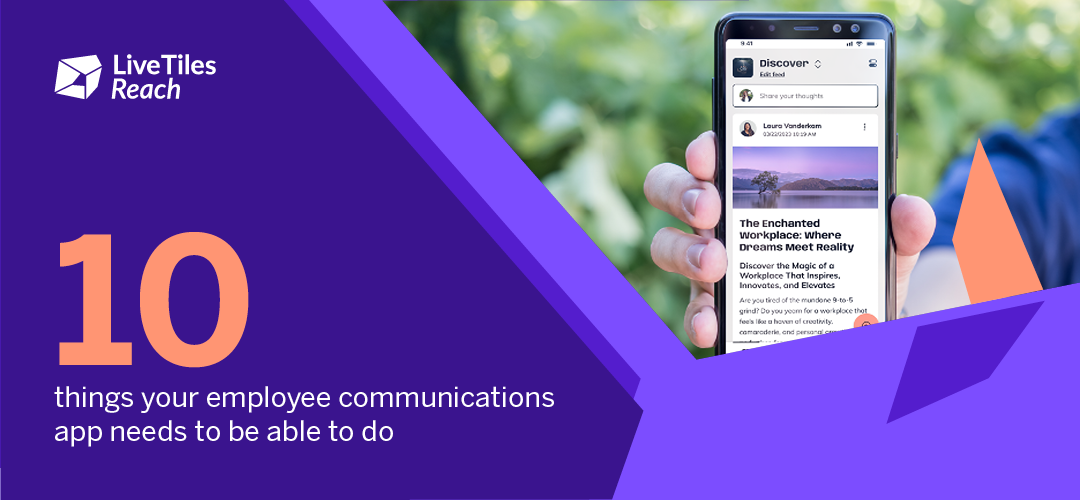This is the second in a series of articles about frontline workers, exploring the roles and challenges of these vital employees and how businesses can support their success.
In 2021, many frontline workers are more disconnected from their organizations and disengaged from their work than ever before. And harnessing digital transformation is the answer to employee engagement and empowering these vital staff members to be as productive as possible.
However, companies face several hurdles standing in the way of this. We’ll examine those here.
First thing’s first…
Let’s start with the good news. There are few, if any, technological barriers to digitally empowering today’s frontline workers. The cloud, enterprise mobility, and other developments have made digital transformation much more technically feasible for the frontline. In fact, the problems lie elsewhere.
Organizational issues are the main factors keeping businesses from engaging and empowering frontline employees via technology. Here are the four most important ones:
- Insufficient funding for technology and training
- Staff turnover and related time constraints
- Solutions aren’t adequate for workers’ needs
- No buy-in from leadership (or others)
1. Insufficient funding for technology and training
According to a 2020 study by the Harvard Business Review (HBR), 43% of those surveyed said the cost of rolling out digital technologies to employees was one of the biggest barriers to digitally empowering firstline (frontline) workers. As with any initiative of this kind, those pushing for digital transformation often find these three dreaded letters looming large over everything they want to achieve: R.O.I.
Investment can be difficult to justify to higher-ups, who may not be swayed unless you can persuade them there will be concrete returns in terms of savings or profits. And this means that it’s often challenging to raise the sums needed to truly make a difference.
How do you build your case for change? Obviously, you need to emphasize the importance and benefits of frontline employee engagement. But it’s also crucial to underline the results of not making the necessary investment, such as:
- Inefficiency and lost productivity due to poor scheduling and task-management
- Lower employee retention due to dissatisfaction and disengagement with work
- Lost opportunities for improvement and innovation from vital frontline insights
2. Staff turnover and related time constraints affecting employee engagement
In many businesses and industries, frontline workers are more transient than other employees and turnover rates are higher. A degree of this may be due to job dissatisfaction – something your engagement and empowerment efforts are aimed at remedying.
Employee turnover can pose a challenge because organizations have a shorter time window to achieve certain things. These include training employees in technology, engaging them, and getting them working and collaborating more effectively.
So, how do you reduce employee turnover, improve retention, and engage them more while they’re working for you? The following are good starting-points:
- Proactively seek feedback from frontline workers to improve their roles
- Provide incentives for longer-term retention such as incremental leave increases
- Increase professional development opportunities available to workers
3. Solutions aren’t adequate for workers’ needs
The HBR study also found that less than half of those surveyed said that their existing IT resources “adequately support firstline workers”. This can be a result of using legacy systems that are unfit for purpose today, but it can also be a result of choosing more modern solutions that just aren’t right for your organization, workers, and business needs.
A rigidly inflexible, generic, one-size-fits-all solution may not deliver value for frontline workers because it doesn’t cater to the specific needs of their role or your industry. If that’s the case, they simply won’t use it – which is a common way for frontline digital empowerment to fail.
What are your options to ensure this doesn’t happen?
- Tailor-made solutions likely to need extensive investments of cost and time to create
- Ready-made but customizable solutions that can be shaped to workers’ needs
The latter will not only be an easier sell to cost-averse business leaders but will be quicker and easier to implement and can also be further customized later if needed. Consider the long-term: you want your technology to evolve along with your business, not be firmly fixed into the point in time when it was made and unchangeable without more costly, time-consuming software development. Think flexible for the future.
4. No buy-in from leadership (or others)
A common business maxim is that change must be led from the top. And, while the C-suite is likely to recognize digital transformation’s impact on knowledge workers and other back-office staff, some executives are less supportive of providing the same benefits to those on the front lines.
It’s a mindset that’s changing, however. In the HBR study, 73% of executives surveyed said they’re investing in digital tools for “firstline” workers. But there are likely to be pockets of resistance within every organization. The study also found that 23% cited a “lack of commitment among middle managers” – so, even if C-level execs are fully on board, lower-level management may consider frontline digital enablement a waste of time or money, or just an unwelcome hassle for themselves.
The only solution is education and advocacy. The classic change management measures for any kind of digital transformation, such as appointing change champions, can be very valuable here. But don’t neglect to use your new digital technologies themselves to reach, educate, and persuade staff across every level of your organization. After all, you’re taking on these tools to boost employee engagement and bring your organization together – what better first use of them than to encourage their own adoption?
Need some ideas? You could:
- Provide technology training webinars and record them for on-demand viewing
- Create a digital information repository for business processes and tools
- Encourage chat groups for exchanging knowledge and seeking advice.
Ready to overcome the challenges of frontline employee engagement?
So, now you’ve explored the challenges. Hopefully you have a better sense of how to engage frontline workers successfully via digital transformation.
They say that nothing worthwhile is ever easy. That’s a pretty broad statement, but in this case it rings true. For all the possible hurdles in your way, the benefits of achieving better employee engagement are more than worth it.
Want to learn more about how to engage frontline workers and empower them to fulfill their full potential? Don’t miss our next article in this series. Or if you’d like to discuss how LiveTiles can help your business achieve greater employee engagement, get in touch with us today.







